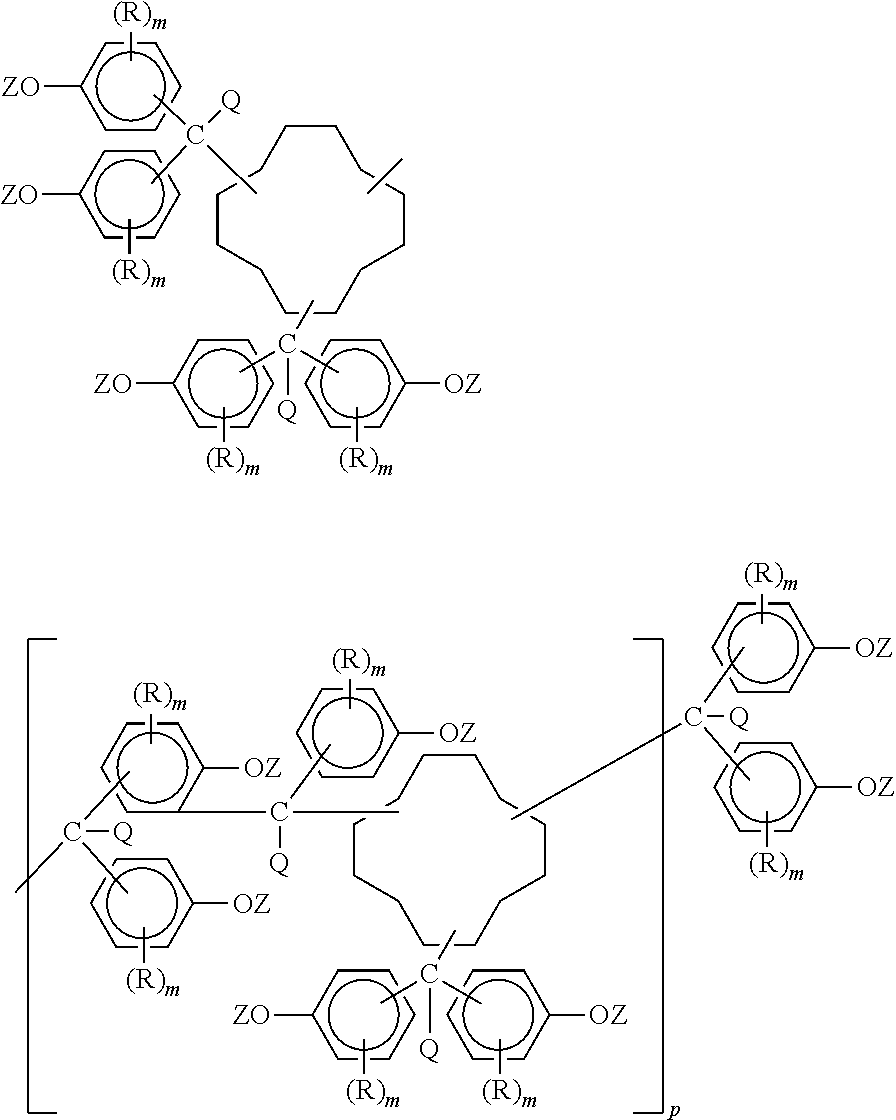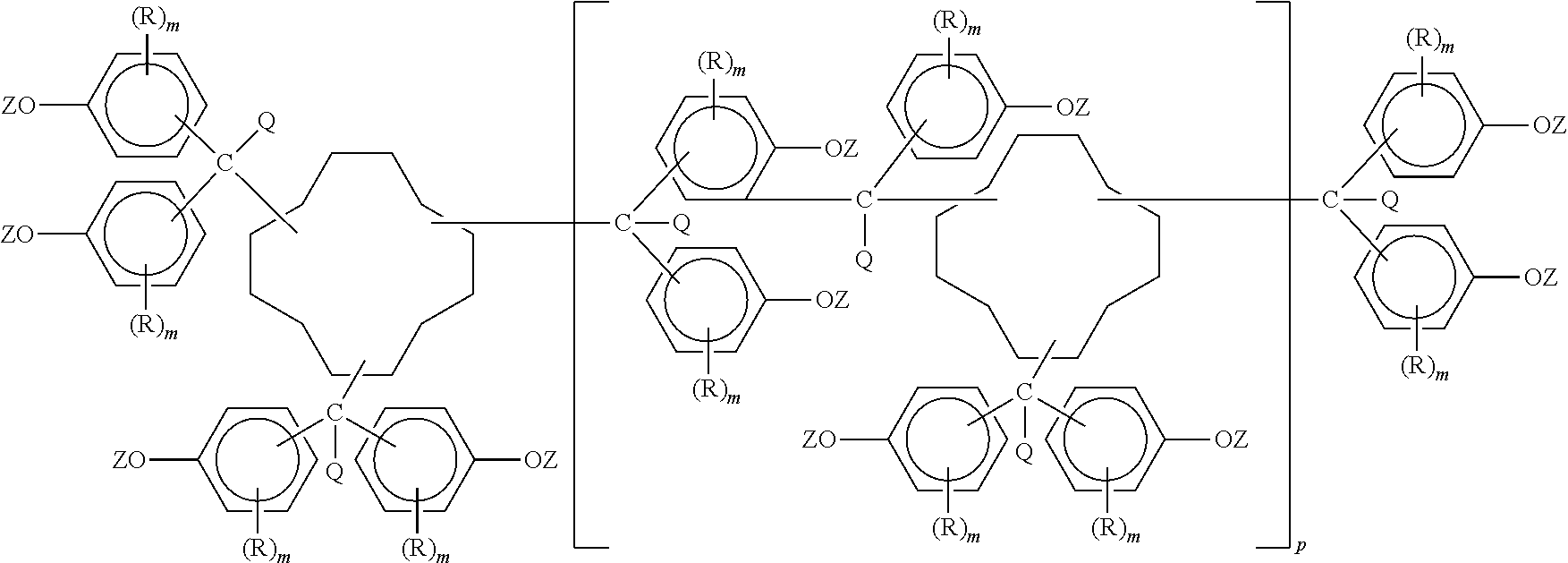Preparation and uses of epoxy resins of cyclododecane polyphenols
a technology of cyclododecane polyphenols and epoxy resins, which is applied in the field of preparation and use of epoxy resins, can solve problems such as difficulties in using such resins
- Summary
- Abstract
- Description
- Claims
- Application Information
AI Technical Summary
Benefits of technology
Problems solved by technology
Method used
Image
Examples
example 1
Synthesis of Epoxy Resin of Polyphenol of CDD Trialdehyde
[0064]A. Phenolation of CDD Trialdehyde
[0065]CDD trialdehyde obtained from the hydroformylation of cyclododecatriene was analyzed by gas chromatography demonstrating the following composition: cyclododecatriene (0.15 wt. %), CDD monoaldehyde (0.16 wt. %), CDD dialdehyde (9.52 wt. %) and CDD trialdehyde (88.72 wt. %). Reaction of CDD trialdehyde (39.74 g, 0.16 mole, 0.48 aldehyde eq) and molten phenol (301.2 g, 3.2 moles) using 3-mercapto-1-propane sulfonic acid catalyst (total catalyst used was 1.25 g, 0.05 mole % with respect to CDD trialdehyde reactant) provided the polyphenol of CDD trialdehyde as a reddish tan colored powder (107.00 g). HPLC analysis of a sample of the product demonstrated the presence of 1.89 area % residual phenol. FTIR spectrophotometric analysis of a KBr pellet revealed complete disappearance of the aldehyde carbonyl stretch at 1721.9 cm−1 with appearance of strong aromatic ring absorbance at 1610.8 (s...
example 2
Preparation of Curable Blend of Epoxy Resin of Polyphenol of CDD Trialdehyde and Diethylenetriamine (DETA)
[0070]Epoxy resin of polyphenol of CDD trialdehyde (2.1608 g, 0.009446 epoxide eq) from Example 1 B was dissolved in THF (20 mL) under a dry, nitrogen atmosphere. The THF used had been purified by passing through a column of heat activated alumina under a dry, nitrogen atmosphere. DETA (0.1949 g, 0.009446 —NH eq) was weighed into the glass bottle containing the THF solution under a dry, nitrogen atmosphere followed by shaking to provide a homogeneous solution. All weighing was completed on scales with 4 place accuracy. A portion (approximately 0.75 g) of the THF solution was added to an aluminum dish and devolatilized in the 21° C. vacuum oven. For analysis of curing, a DSC 2910 Modulated DSC (TA Instruments) was employed, using a heating rate of 7° C. per min from 0° C. to 250° C. under a stream of nitrogen flowing at 35 cubic centimeters per min, with holding at 0° C. for 2 mi...
example 3
Preparation of Curable Blend of Epoxy Resin of Polyphenol of CDD Trialdehyde, Epoxy Resin of Diphenol of Cyclododecanone (eCDON), and Diethylenetriamine (DETA)
[0072]A. Cure Profile of Curable Blend
[0073]Epoxy resin of polyphenol of CDD trialdehyde (0.5522 g, 0.0024139 epoxide eq) from Example 1 B and eCDON (2.8599 g, 0.0117539 epoxide eq) was dissolved in THF (35 mL) under a dry, nitrogen atmosphere. The THF used had been purified by passing through a column of heat activated alumina under a dry, nitrogen atmosphere. The eCDON used was prepared by phenolation of cyclododecanone and possessed an EEW of 243.32. DETA (0.2923 g, 0.014166 —NH eq) was weighed into the glass bottle containing the THF solution under a dry, nitrogen atmosphere followed by shaking to provide a homogeneous solution. All weighing was completed on scales with 4 place accuracy. A portion (approximately 0.75 g) of the THF solution was added to an aluminum dish and devolatilized in the 21° C. vacuum oven. For analy...
PUM
| Property | Measurement | Unit |
|---|---|---|
| reaction temperature | aaaaa | aaaaa |
| Tg | aaaaa | aaaaa |
| pressure | aaaaa | aaaaa |
Abstract
Description
Claims
Application Information
 Login to View More
Login to View More - R&D
- Intellectual Property
- Life Sciences
- Materials
- Tech Scout
- Unparalleled Data Quality
- Higher Quality Content
- 60% Fewer Hallucinations
Browse by: Latest US Patents, China's latest patents, Technical Efficacy Thesaurus, Application Domain, Technology Topic, Popular Technical Reports.
© 2025 PatSnap. All rights reserved.Legal|Privacy policy|Modern Slavery Act Transparency Statement|Sitemap|About US| Contact US: help@patsnap.com



